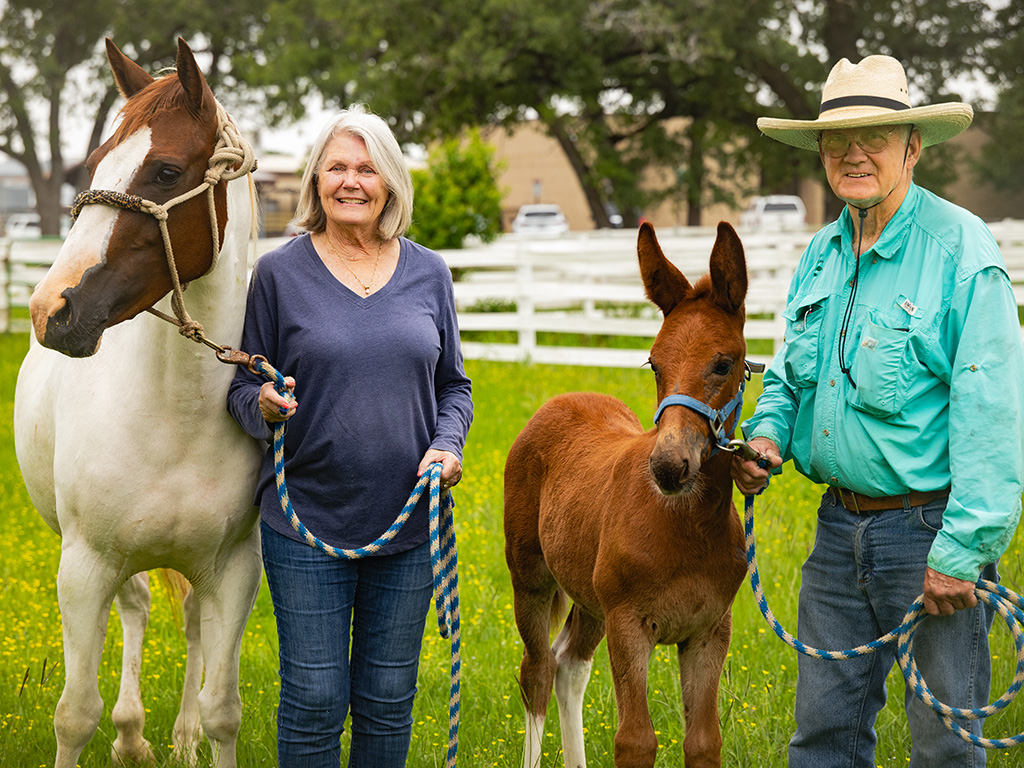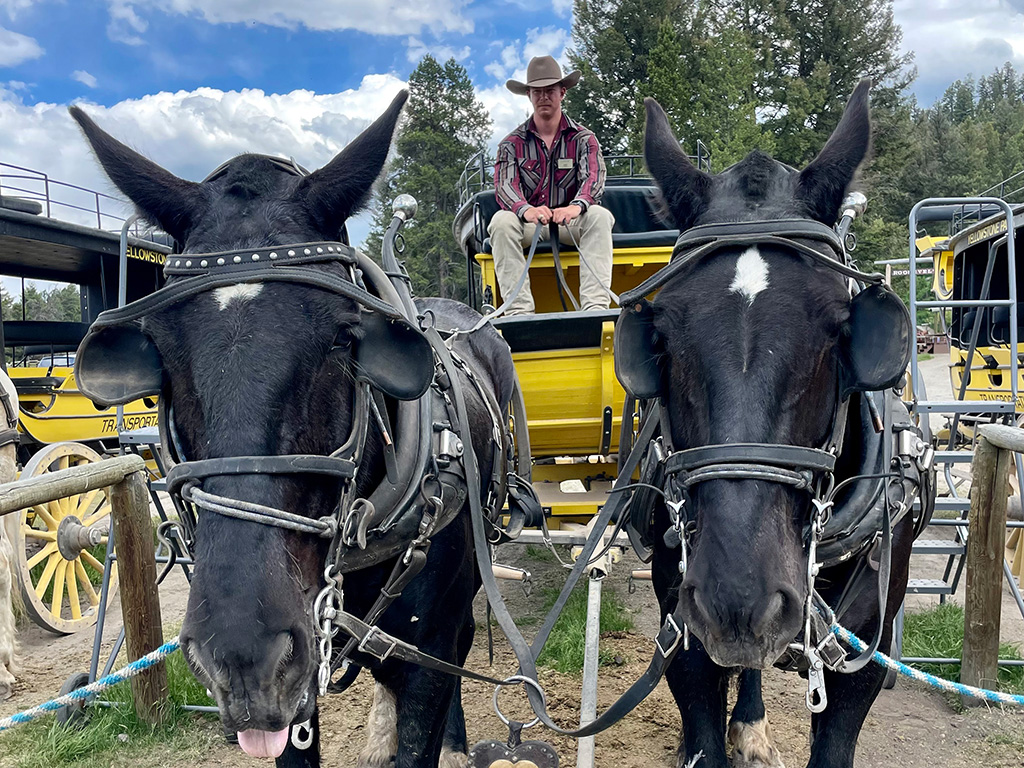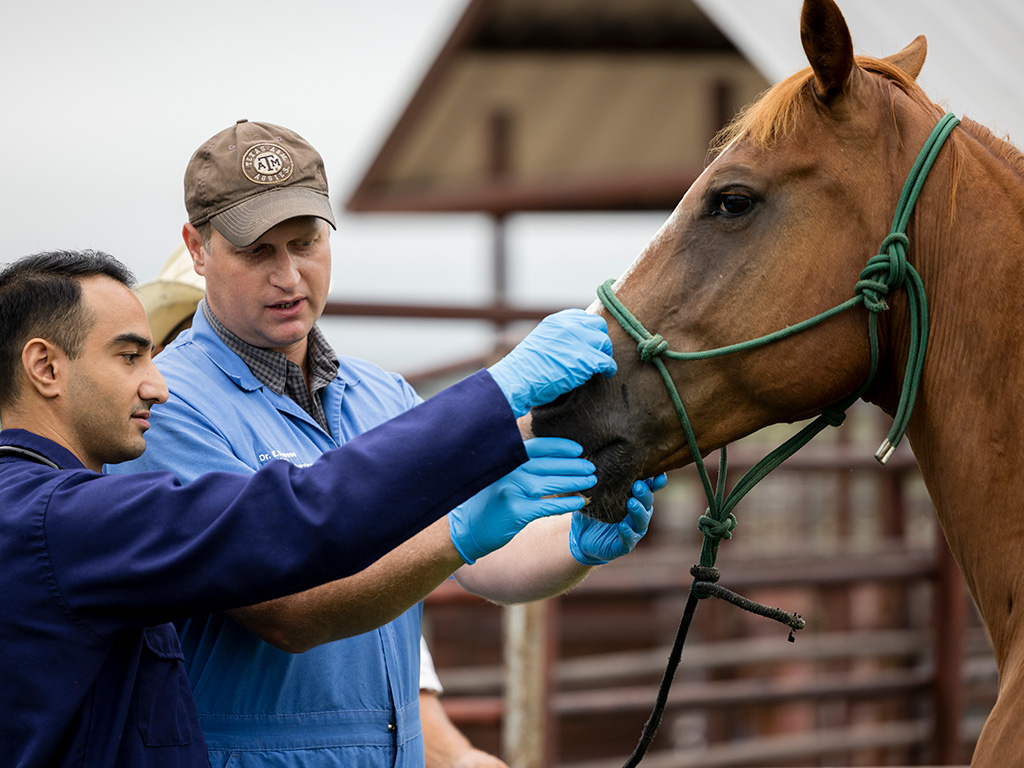Texas A&M Veterinarians Help Service Dog Overcome Heartworms
Story by Courtney Price, VMBS Marketing & Communications
With the help of Texas A&M experts, one family championed their beloved service dog, saving him from heartworms as repayment for the love he had given them in their times of need.
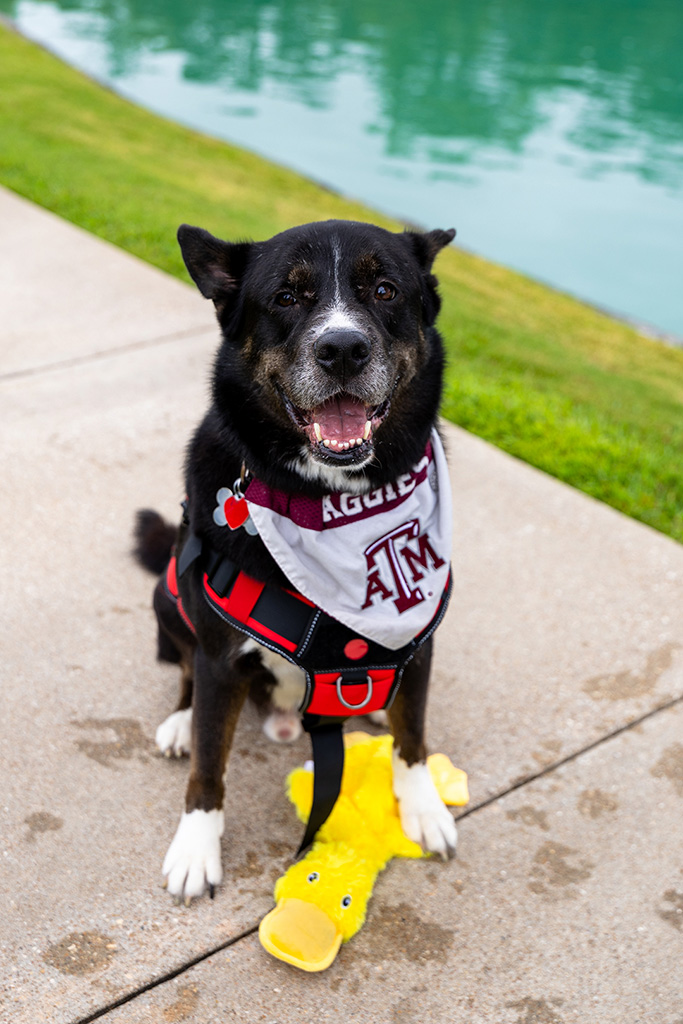
When Texas A&M University freshman Paola Assanmal felt like she was at rock bottom, she found a friend in Rocky, a 4-year-old pit bull and Siberian husky mix that she met at an animal shelter in her hometown of League City, Texas.
“Two years ago, I was diagnosed with bipolar disorder, which is characterized by high highs when I’m in a good mood and really low lows when I’m not,” Assanmal said. “It has felt like being on a roller coaster while my doctors try to get my medication dosage right.
“When I met Rocky, I had just been released from an inpatient psychiatric facility, and I was feeling lost and hopeless,” she said. “My parents took me to an animal shelter to pick out a new friend, and I was drawn to Rocky because he seemed so lonely in that kennel, just like how I felt.”
Understanding the medical benefits of canine companionship, Assanmal and her family spent several months helping Rocky train to become a service dog. During his training, Rocky seemed to realize that Assanmal and her family were “his humans,” and he overcame his own fears so that he could protect them.
“When we first got him, he was afraid of anything with wheels; he wouldn’t go on elevators, and he didn’t like it if the flooring changed,” said Michael Kingery, Assanmal’s father. “But he got past all of that. I’m a nurse, and I often take him to the hospital with me. Now, if there’s someone coming down the hallway with a cart, he will move to put himself between me and the cart.”
Through service animal training, Rocky learned to help with things like reminding Assanmal to take her medication. He also learned to lean on her to apply comforting pressure during episodes of intense mood changes.
“Rocky also helps my father, who was diagnosed with bladder cancer and is undergoing chemotherapy and radiation,” Assanmal said. “He alerts us if my dad loses his balance or falls and has even stayed with him in the hospital.”
The integral role that Rocky plays in Assanmal and Kingery’s lives made it all the more devastating when they learned during a routine check-up that Rocky had heartworms.
“Our local veterinarian told us to just let the illness play out,” Assanmal said. “But we knew we couldn’t do that to Rocky, not after he fought for us. We knew we had to fight for him.”
A Friend In Times Of Need
As she recalls, the months after receiving her diagnosis were very difficult for Assanmal.
“I was very sad and angry at life,” she said. “My mom was the one who suggested getting a puppy from the shelter. We have three other dogs, but this would be a friend just for me.”
Assanmal and her family visited several shelters before she found Rocky.
“It really surprised us to see that there was one dog that was not barking, not jumping up to greet us,” she said. “He was just lying on the floor, looking up at us without a sound, and I completely fell in love with him right there.”
Despite their more somber introduction, Rocky’s personality finally began to shine after being adopted.
“He’s the best dog I’ve ever had in my life,” she said. “He’s so calm, and he brings me so much joy.”
One of Rocky’s favorite pastimes is trying to make friends with the ducks at the park.
“Normally, Rocky’s not a fan of pools or big bodies of water,” Kingery said. “But we’ve discovered that he loves ducks. We took him to a pond near Kemah, Texas, and he was so excited that he dove right into the water. We’re hoping one day to have a pond so he can finally make a duck friend.”
In the meantime, Rocky also has made lots of friends through helping patients at HCA Houston Healthcare Clear Lake, the hospital where both of Assanmal’s parents work.
“Rocky’s a volunteer at the hospital,” Kingery said. “He goes on rounds and people like to hug and pet him. He goes to every event that he can to show support.”
Difficult News
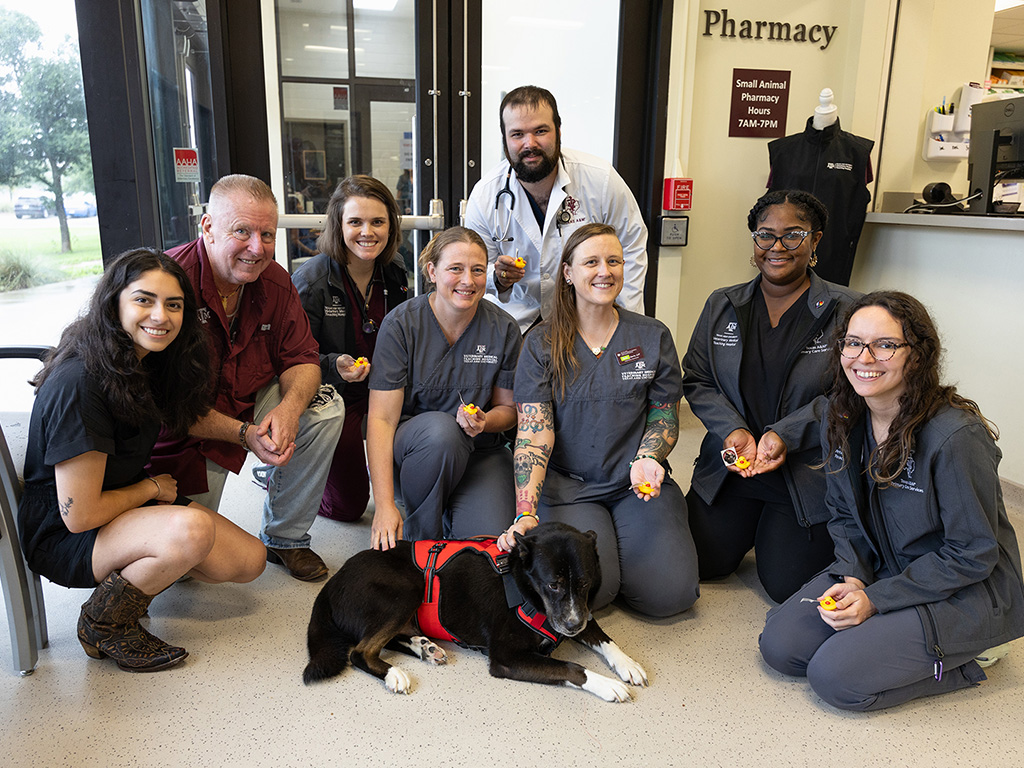
During his routine wellness examination and preventative checkup, Assanmal’s family received the unfortunate news that Rocky had heartworms.
“The news came as a huge shock to us because we had never really thought about the reality of heartworms,” Assanmal said. “We have three dogs that have been very healthy, and we just didn’t know anything about the disease.”
After learning about the damage that heartworms can do to their hosts, Assanmal knew she had to find a solution to help Rocky.
“We were told that there is a treatment, but that it’s very expensive, so our vet recommended that we just do nothing,” she said. “I was shocked to receive that advice, but I knew about the Small Animal Teaching Hospital (SATH), and I knew instantly that I had to take Rocky there. I knew it was the best care I could possibly get him, and he had to have the best after everything he’d done for us.”
After reaching out to everyone they knew who might be able to help, Assanmal and her mother learned about the SATH’s Capper & Chris Save the Animals Fund. This compassionate care fund was one of the first giving opportunities created at the VMBS to help animals in need and to provide veterinary students valuable experience.
“It was such a huge help,” Assanmal said. “It made it possible for us to fund his treatment. We were able to cover the rest of the amount thanks to an insurance refund — when it came, we knew that money had to go to help Rocky.”
Beginning The Treatment Process
The process for removing heartworms isn’t easy, but so far, Rocky has done remarkably well.
“Once we have a positive diagnosis, we first need to weaken the heartworms,” said Dr. Brad Bennett, a clinical assistant professor at the SATH. “Heartworms carry a bacteria called Wolbachia that they depend on to survive. We give patients a drug for about a month that kills the Wolbachia and increases the effectiveness of the rest of the treatment. Then we make sure that the patient is on heartworm prevention for two months to kill any baby worms.
“The next step is injections to kill the adult worms, which are given in three stages over 4-5 months,” he said.
While the combined process is highly effective at removing heartworms, it can be tough on the patient.
“The injections are given in the back muscles, a little bit higher than where the pelvis is,” Bennett said. “As with any injection, there can be inflammation afterwards and sometimes we need to give pain medications. We assess every patient individually so they can have the best outcome possible. Several months after the injections are complete, we test them again to make sure the heartworms are gone.”
Fortunately, Rocky has already completed the injections and is well on his way to being heartworm-free.
“It’s good that Rocky’s heartworms were caught before they caused many symptoms,” Bennett said. “If you’re a dog owner, it’s important to make sure that your dog is up to date on their heartworm prevention and that they get regular checkups.
“Because of the life cycle of heartworms, they don’t always show up in blood samples, so it can take a few tests before they are detected,” he said. “Keeping up with medications and checkups helps to prevent an infection and ensure that if one happens, it is caught as early as possible.”
As an active dog, it was also fortunate that Rocky’s family was so devoted to helping him get treatment.
“One of the most important rules for dogs that have heartworms is to keep them quiet, because activity and excitement can cause them to get blood clots,” Bennett said. “Blood clots in dogs are a big deal because the drugs we use to break up a clot take several days to work, and that often means that the patient will need oxygen and other supplemental treatment during that time.”
A Hopeful Future For Rocky

For Assanmal and her family, Rocky’s heartworm treatment is a chance to give back to a loyal friend who has already given them so much.
“We’re a team,” she said. “He deserves a chance at a long life of walks under the Century Tree. Rocky should live to see me graduate, see my future children, as well as see my dad ring the bell once he completes his cancer treatment.”
Rocky has also inspired Assanmal and Kingery to raise awareness about heartworms.
“Every new friend Rocky meets receives a rubber ducky and a sticker of Rocky,” Assanmal said.
Thanks to the generosity of donors who contribute to the Capper & Chris Fund, the Texas A&M veterinary team, and a dedicated family, Rocky has a chance to continue changing lives and supporting the family who gave him a loving home.
###
Note: This story originally appeared in the Fall 2024 issue of VMBS Today.
For more information about the Texas A&M College of Veterinary Medicine & Biomedical Sciences, please visit our website at vetmed.tamu.edu or join us on Facebook, Instagram, and Twitter.
Contact Information: Jennifer Gauntt, Director of VMBS Communications, Texas A&M College of Veterinary Medicine & Biomedical Sciences, jgauntt@cvm.tamu.edu, 979-862-4216
You May Also Like

